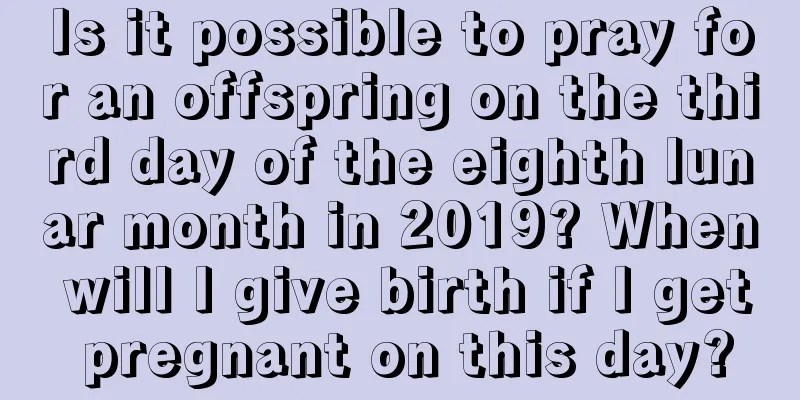Can I celebrate the New Year during the Lantern Festival? What are the "special" activities during the Lantern Festival?

Introduction: The Lantern Festival is a traditional Chinese festival, but with the expansion of China's influence, many foreigners now also celebrate the Lantern Festival. So, can we visit relatives and friends to wish them a happy new year on the Lantern Festival? Is there anything "special" going on on this day? Let’s explore it together! During the first month of the lunar calendar, you will have a good year. The first month is the most important month of spring. Mr. Shui Mo will share with you some knowledge about January.Can I celebrate the New Year during the Lantern Festival?You can pay New Year’s greetings on the Lantern Festival, and you can pay New Year’s greetings before the Lantern Festival. The Lantern Festival is a traditional Chinese festival that has existed as early as the Qin Dynasty more than 2,000 years ago. According to historical records and folk legends, the fifteenth day of the first lunar month was already taken seriously in the Western Han Dynasty. The activity of Emperor Wu of Han offering sacrifices to "Taiyi" (Taiyi: the god who dominates everything in the universe) in Ganquan Palace on the first night of the first lunar month was regarded by later generations as a precursor to the worship of gods in heaven on the fifteenth day of the first lunar month. Yuanxiao originally meant "the night of the Lantern Festival". Because the main activity of the Lantern Festival on the fifteenth day of the first lunar month is eating glutinous rice balls and admiring the moon at night, the name of the festival later evolved into "Lantern Festival". On the night of the Lantern Festival, the streets and alleys are decorated with lights, people admire the lanterns, guess lantern riddles, and eat Lantern Festival rice dumplings, bringing the celebrations that began on New Year's Eve to another climax and becoming a custom passed down from generation to generation. When the Lantern Festival was in its early stages of being a festival, it was only called the fifteenth day of the first lunar month, the middle of the first lunar month, or the full moon. After the Sui Dynasty, it was called Yuan Xi or Yuan Ye. Influenced by Taoism in the early Tang Dynasty, it was also called Shangyuan, and it was occasionally called Yuanxiao in the late Tang Dynasty. But since the Song Dynasty, it has also been called Dengxi. In the Qing Dynasty, it was called the Lantern Festival. Abroad, the Lantern Festival is also known as The Lantern Festival. What are the "special" activities during the Lantern Festival?South Korea: Don’t eat Yuanxiao, eat grainsThere is no Lantern Festival in Korea. The fifteenth day of the first lunar month is called "the first lunar month's big moon day", which means "looking at the full moon". Unlike China, they do not eat Yuanxiao on this day. Instead, they eat five-grain rice made from a mixture of glutinous rice, sorghum rice, red beans, yellow rice, black beans and other grains, and a variety of nuts, such as peanuts, walnuts, pine nuts, chestnuts, ginkgo, etc. It is said that it can make teeth stronger and prevent and treat skin diseases such as carbuncles. In addition, people drink "ear-clearing wine" to pray for no ear diseases in the new year and to hear only good news throughout the year. Some traditional celebrations of the fifteenth day of the first lunar month are still preserved in rural South Korea. For example, the "Burning the Moon House" is a conical house frame made of tree trunks or bamboos, on which pieces of paper with New Year wishes are hung. After the full moon rises, people use torches in their hands to light the "moon house" and sing and dance around the fire.Japan: Enjoying Lanterns in ChinatownJapan calls the first month of the Gregorian calendar the New Year, and January 15th is called the Little New Year. There are many folk activities in Japan during the Little New Year, but the Lantern Festival on the 15th day of the first lunar month is relatively unfamiliar to most Japanese. On the fifteenth day of the first lunar month, Chinatown in Japan is very lively. For example, Yokohama Chinatown holds a Lantern Festival lantern-viewing event every year, and some local Chinese and overseas Chinese will go to join in the fun.North Korea: Welcome the moon on the 15th day of the first lunar monthIn North Korea, the Lantern Festival is called "the fifteenth day of the first lunar month." On this day, every household has to cook "five-grain rice" made from a mixture of rice, sorghum, millet, beans and barley. This kind of "five-grain rice" not only symbolizes "a good harvest", but also symbolizes the "five blessings" of longevity, wealth, health, many children and peace. In addition, every household has an indispensable dish on this day, which is the "nine kinds of dishes" made from nine kinds of dried vegetables commonly seen in winter, including dried radish leaves, dried ferns, dried chili leaves, dried platycodon, dried sweet potato vines, and dried gourds. What can arouse people's interest most is the "Welcoming the Moon" at night. It is said that the person who first sees the "big fifteenth" moon will have good things happen to him throughout the year. If an unmarried young man sees it, he will marry a girl as beautiful as the "full moon"; if a married man sees it, he will have a healthy baby.Southeast Asia: Lion dance parade with NanyinThere is a large proportion of Chinese in many Southeast Asian countries, so the Chinese in these places have maintained the customs of southern China. During the Lantern Festival, a traditional Chinese festival, the local Chinese people's New Year customs have maintained their own traditions while integrating with local culture to form distinctive New Year customs. A few years ago, the Singapore Fujian Huayi Association started organizing lively "street parades" during the Lantern Festival, featuring wonderful performances of martial arts, lion dances and Nanyin music. The Lantern Festival is one of the most important traditional festivals for Chinese in Malaysia. Its custom of “throwing oranges and catching bananas” is lively, romantic and unique. The annual Chinese traditional cultural event is held in Singkawang, West Kalimantan Province, Indonesia. The Lantern Festival Parade is an important part of the Chinese New Year celebrations in Singkawang and is also the climax of the event.Summary: After reading the introduction in the above article, we know that we can pay New Year’s greetings on the Lantern Festival, and we also know the special customs and activities of other countries during the Lantern Festival. After reading it, do you have a new understanding of the Lantern Festival? After reading this article, there are more exciting contents in the special topic of the first month of the lunar calendar. Let’s take a look! |
Recommend
Is Valentine’s Day 2022 a good time to get married? Is it a good idea to get married on Valentine’s Day?
I believe everyone knows that you need to choose a...
Is the third day of the eleventh lunar month in 2019 a good day to burn incense and pray?
Everyone goes to the temple to pray for peace, hea...
Is it a good idea to get married on the 14th day of the second lunar month in 2019? Is it a good idea to get engaged and get a marriage certificate?
The beautiful spring has arrived, flowers are blo...
Is it okay to burn incense and pray for blessings on July 23, 2019? Why does the End of Heat come after the Beginning of Autumn?
Introduction: Generally, you need to choose an aus...
Is it appropriate to hold a funeral one day after the beginning of summer on July 5, 2020? When is the beginning of summer this year?
Introduction: Burying the deceased is also an impo...
Is Xiaohan suitable for moving? What should I pay attention to when moving?
Introduction: Xiaohan is coming, is it a suitable ...
Feng Shui sacred objects that can boost wealth for men
There are various Feng Shui sacred objects, just ...
What zodiac sign is your birthday on Dragon Boat Festival 2022? Can I celebrate my birthday on Dragon Boat Festival?
The Dragon Boat Festival is held in midsummer and ...
Can I set up the bed on the 23rd day of the twelfth lunar month in 2021? Is the bed set up okay?
The pros and cons of setting up the bed at differe...
What zodiac sign is March in the lunar calendar of 2020? Is it good for a baby born in March in the lunar calendar to be a rat?
Introduction: Children born on different days have...
Is November 14th of the lunar calendar 2019 a suitable day to pray for a child?
Is November 14th of the lunar calendar 2019 a suit...
List of the positions of the God of Happiness on the 17th day of the fourth lunar month in 2020
An overview of the direction of the God of Happin...
Is it okay to have a caesarean section on the first day of the fourth lunar month in 2022? What are the benefits of a caesarean section?
Speaking of caesarean section, I believe many peop...
Which year will people born in have the best fortune in 2017?
Introduction: 2017 is the Year of the Rooster in t...
Is it good to get engaged during the Ghost Festival? Is the 2018 Ghost Festival suitable for engagement?
Engagement is the most important event after marri...









